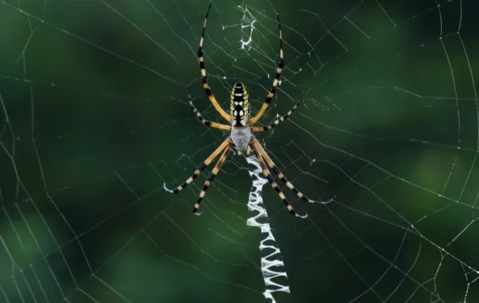Are There Banana Spiders in South Florida?
In Florida's varied habitats, the banana spider stands out with its distinctive yellow and black markings. These spiders, known for their impressive web-spinning, are vital in controlling insect populations by catching flies, mosquitoes, and other small pests in their orb-shaped webs.
Despite their size and vibrant appearance, banana spiders are harmless to humans. Their venom isn't dangerous, and bites are rare, typically occurring only through accidental contact. Dive into the intriguing world of these beneficial arachnids and learn how they contribute to Florida's ecosystem.
Key Takeaways
- Banana spiders are large spiders found in various habitats in Florida, adding a unique visual element to the local fauna.
- As a natural pest control, banana spiders play a crucial role in the ecosystem by preying on various small flying insects.
- Despite their formidable size and appearance, banana spiders pose little threat to humans, and bites are sporadic and harmless.
What Are Banana Spiders?
Known for their impressive large webs and vibrant colors, banana spiders are a common bug in Florida.
Scientific Classification
Along with the black widow and giant wood spider, the banana spider is one of the most common species of spiders in North America.
Its scientific name is Trichonephila clavipes, formerly Nephila clavipes. It is often confused with spiders from the Argiope genus, which share similar striking appearances.
Kingdom | Animalia |
Phylum | Arthropoda |
Class | Arachnida |
Order | Araneae |
Family | Nephilidae |
Genus | Trichonephila |
Species | Trichonephila clavipes |
Common Name | Banana Spider |
Physical Characteristics
Here are the key features that make banana spiders one of the notable types of spiders in Florida.
- Size: Female banana spiders are enormous, with a body length of up to 1.5 inches and a leg span reaching 5 inches. Males are notably smaller.
- Colors and Markings: These spiders are recognized for their vivid yellow and black markings. The females typically exhibit brighter and more pronounced colors.
Banana Spiders Webs and Diet
Banana spiders exhibit distinctive behaviors regarding their web construction and method of capturing prey.
While they are a common sight in Florida, similar species of banana spider have also been spotted as far north as North Carolina
Web Construction
Banana spiders are known for their unique golden webs, which serve as effective traps for various insects that make up their diet, according to research from the University of Florida.
Features | Description |
Web Construction | Intricate and extensive, spanning several feet |
Web Center | Denser silk, zig-zag pattern (stabilimentum) for strength and insect attraction |
Web Location | Open, sunny areas; woodlands, forest edges, gardens |
Hunting Methods and Diet
The diet of banana spiders primarily consists of flying insects. When insects become trapped in the web, they quickly immobilize it with its venomous bite. They are an adept hunter to capture a variety of prey, such as:
- Flies
- Bees
- Wasps
- Dragonflies
- Beetles
Banana Spider Life Cycle
Egg Stage: The Beginning of Life
- Protection in Silk: Female banana spiders lay hundreds of eggs, wrapping them in a protective silk sac. These sacs are strategically placed, hanging in the spider web, or tucked away in concealed spots.
- A Mother's Care: The eggs remain in the sac, safeguarded by the vigilant female spider, marking a quiet yet critical phase in the life cycle.
Spiderlings: The First Adventure
- Emergence: From these sacs, spiderlings hatch fully developed, ready to embark on their life's journey.
- Ballooning: A remarkable survival tactic, these young spiders use ballooning – floating away on silk strands carried by the wind – to disperse and find their territory.
Adulthood: Survival and Reproduction
- Growth and Development: The spiderlings grow, shedding their exoskeletons several times in molting.
- Mating Rituals: As adults, they engage in intricate mating rituals.
- Cycle Repeats: After mating, the female prepares for the next generation, laying eggs and continuing the life cycle.
Are Banana Spiders Dangerous?
Whether you’re one of the hikers or not, you should be aware of the spiders' venom potency, the necessary precautions, and first aid measures in case of a bite.
Banana Spider Venom Potency
A banana spider, often called a golden silk orb-weaver spider, possesses venom used primarily for subduing prey.
The venom is comparable in strength to a bee sting for humans. It is not usually as harmful as the bite from a tarantula or the Brazilian Wandering spider (Phoneutria) from South America.
However, every individual reacts differently; some may experience more pronounced symptoms.
Generally, these spiders are not considered among the most dangerous spiders in North and Central America.
First Aid for Banana Spider Bites
Avoiding wooded areas and other typical habitats during banana spiders' active seasons can minimize the chances of encountering them.
In case of bites from banana spiders, follow this three-step first aid:
- Clean the bite area with soap and water to prevent infection.
- Apply a cold compress to reduce swelling.
- Seek medical attention if symptoms worsen or if the individual is known to have severe allergic reactions.
Having an antivenom for a banana spider bite is unlikely, as their venom seldom causes severe human issues, unlike that of a brown recluse spider.
Preventive Measures for Spider Bites
You can prevent spider bites by following the checklist below:
- Wear gloves and long sleeves when working in spider-prone areas.
- Keep dense vegetation trimmed to deter spider habitation near homes.
- Consult pest control for advice on spider deterrence and services.
